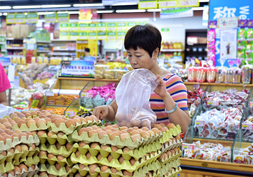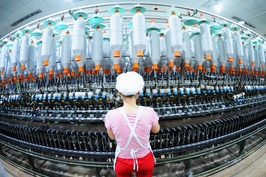Update: Food Prices Push Consumer Inflation to Seven-Month High

* China’s consumer price index rose 2.5% year-on-year in September
* Producer price index increased 3.6% from a year earlier, down from August’s 4.1% growth rate
(Beijing) — Consumer prices rose at their fastest pace in seven months in September as crop rotation and bad weather pushed up food prices, the government said Tuesday.
The consumer price index (CPI), which measures the prices of a basket of consumer goods and services, rose 2.5% year-on-year in September, marking the highest growth rate in seven months, according to data released by the National Bureau of Statistics (NBS).
The producer price index (PPI), which tracks the prices of goods bought and sold by manufacturers and mining companies, increased 3.6% from a year earlier in September, down from August’s 4.1% growth, NBS data showed. The latest PPI growth reading was the lowest in five months, partly due to a high base comparison from a year earlier.
“The recent rise in (the) CPI is due to temporary disruptions to food supply and is unlikely to prevent the People’s Bank (of China) from loosening monetary policy further in the coming months in a bid to shore up economic growth,” Julian Evans-Pritchard, an economist with research firm Capital Economics, said in a note.
Generally speaking, low inflation gives central banks more wiggle room to loosen their grip on liquidity and allow more money to flow into the economy.
People’s Bank of China Governor Yi Gang said Sunday that there’s still ample space to adjust interest rates and reserve requirement ratios for banks, indicating the central bank may continue to inject liquidity into the banking system to grease the wheels of the economy as trade tensions escalate with the U.S.
From January to September, the CPI grew 2.1% year-on-year on average, and the PPI grew 3.6%, which was in line with Yi’s expectation that the CPI should grow slightly more than 2% in 2018, and the PPI between 3% and 4%.
“As inflation is now evolving in line with expectations, its influence on policy should be limited,” said David Qu, economist at Australia and New Zealand Banking Group.
The growth of PPI was mainly driven by higher prices in the oil and gas extraction sector, which were up 41.2%, as oil and gas prices rose in global markets.
September’s oil price gains would not be sustainable, which is reflected in falling prices this month, said Evans-Pritchard. “The bigger picture is that broader factory-gate price pressures still appear to be cooling alongside economic activity,” he said.
Runaway inflation is unlikely to occur in China right now given the softening economy and tightened liquidity, said Larry Hu and Irene Wu, of consulting firm Macquarie Group, in a joint note. They also predicted CPI inflation would rise by around 2.5% in October and 2.3% for all of 2018.
“The major risk is of course oil prices. The ongoing trade tension with the U.S. could also push up prices for certain goods such as soybean, but the impact is relatively limited at around 0.2 percentage point for CPI inflation, in our view,” they added.
Contact reporter Liu Jiefei (jiefeiliu@caixin.com)

- 1China Moves to Tighten Air-Quality Standards as Beijing Reports Best-Ever Skies
- 2China Threatens EU After Carbon Border Tax Takes Effect
- 3Gansu Ex-Vice Governor Jailed 15 Years for Bribery, Insider Trading
- 4Cover Story: How Resource Nationalism Is Redrawing the Global Mineral Playbook
- 5Trump Orders Chinese-Controlled Firm to Unwind Purchase of U.S. Chip Assets
- 1Power To The People: Pintec Serves A Booming Consumer Class
- 2Largest hotel group in Europe accepts UnionPay
- 3UnionPay mobile QuickPass debuts in Hong Kong
- 4UnionPay International launches premium catering privilege U Dining Collection
- 5UnionPay International’s U Plan has covered over 1600 stores overseas






